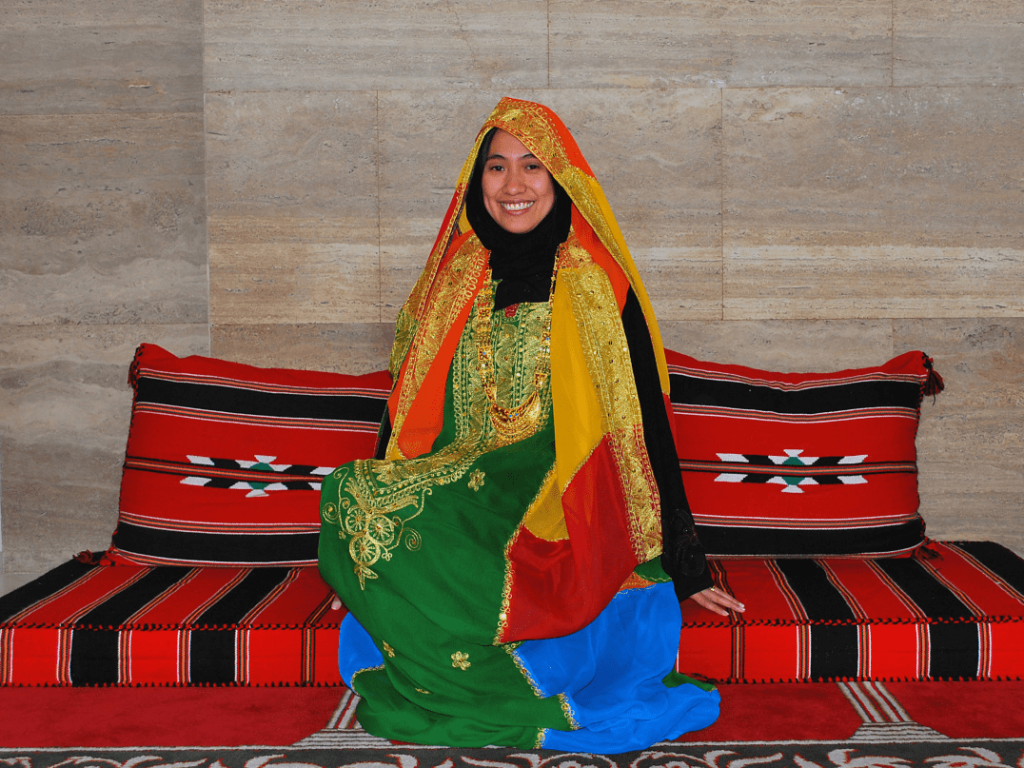Hello there! If you’re learning Arabic and planning to visit Bahrain, it’s a great idea to know about the local Bahrain dress code. This article will take you on a journey through traditional fashion and help you choose your outfits to be both stylish and respectful of the local culture.
Traditional Attire: A Look at the Bahraini Dress Code
The traditional clothing of Bahrain is known for its elegance and rich history, making it an integral part of the nation’s identity.
For Men: The Iconic Thobe and Headwear
- The Thobe (or Dishdasha): This is a long, loose-fitting robe with long sleeves. Its color often reflects the season:
- In summer: Light cotton and white are preferred.
- In winter: Darker colors like black and brown are chosen for warmth.
- The Headwear: A man’s headwear consists of three main pieces:
- The Kufi: A small, white cap worn under the Ghutra.
- The Ghutra: A large piece of cloth (usually white or red and white) placed over the Kufi.
- The Egal: A thick, black rope that holds the Ghutra in place.
- The Bisht: A formal, elegant cloak worn over the Thobe for major occasions like weddings, Eid celebrations, and official meetings. It’s often embroidered with gold.
For Women: Grace and Elegance in the Abaya
- The Abaya: This is a long, loose-fitting black cloak that women wear over their clothes as a sign of modesty and elegance.
- The Hijab: A head covering that conceals the hair and neck.
- Thoub Ann-nashil: This is a special traditional dress for happy occasions. It is characterized by its vibrant colors and luxurious gold embroidery, and it’s considered one of the most beautiful heritage garments.
- The Bukhnuq: A black cloak decorated with gold, traditionally worn by young girls during holidays and special events.
Dress Code for Visitors (Bahrain Dress Code)
There are no strict laws for visitors’ attire, but it’s always recommended to wear modest clothing to show respect for the culture. The golden rule is: cover your shoulders and knees.
In Public Places
- Malls and Restaurants: You can wear long trousers, skirts that reach the knee, medium-length dresses, and shirts with sleeves. Avoid transparent or very tight-fitting clothes.
- Private Beaches and Hotels: You can wear regular swimwear, but public nudity is prohibited. It’s advisable to wear modest clothing when you leave the beach or pool area.
- Sports Events (like the Bahrain Grand Prix): The dress code is generally more relaxed, but it’s best to wear smart casual attire to avoid any awkwardness.
In Religious Places
- Mosques: Women must cover their entire body, including their hair. You can usually borrow an Abaya and head covering at the entrance of a mosque. Men must wear long trousers and sleeved shirts.
Additional Packing Tips
When packing for your trip, consider these essential tips to ensure you are comfortable and culturally prepared.
- During Ramadan: It’s best to wear more conservative clothing at all times out of respect for the holy month.
- Fabric: Choose natural, light fabrics like cotton and linen to stay comfortable in the hot and humid climate.
- Accessories: It’s a good idea to carry a light scarf or shawl in your bag to use when needed, especially when visiting traditional places like the souqs (markets).
Conclusion
We hope this guide has given you a clear overview of Bahrain and its culture, especially its dress code. Remember that respecting local traditions, particularly concerning the Bahrain female dress code and general attire, will make your experience richer and more enjoyable. Bahrain is a hospitable and beautiful country, and with a little planning, you’ll love your visit and discover the charm of this Arabian Gulf pearl. We wish you a happy and pleasant trip!
If you wish to learn more about the Arabic language, download our Arabic learning app.



